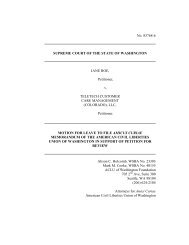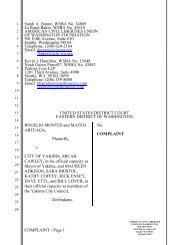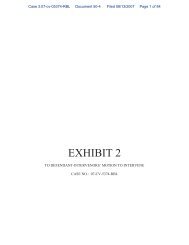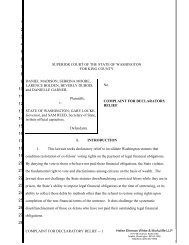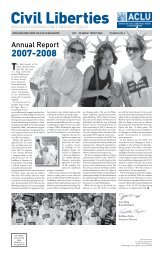BERGER v. CITY OF SEATTLE - ACLU of Washington
BERGER v. CITY OF SEATTLE - ACLU of Washington
BERGER v. CITY OF SEATTLE - ACLU of Washington
Create successful ePaper yourself
Turn your PDF publications into a flip-book with our unique Google optimized e-Paper software.
<strong>BERGER</strong> v. <strong>CITY</strong> <strong>OF</strong> <strong>SEATTLE</strong><br />
263<br />
Supreme Court has made the distinctiveness <strong>of</strong> the interests at<br />
issue in such cases very clear. See Hill v. Colorado, 530 U.S.<br />
703, 728-30 (2000) (upholding 8-foot regulatory buffer<br />
around clinic entrances due to the “unique concerns that surround<br />
health care facilities,” where those using the facilities<br />
“are <strong>of</strong>ten in particularly vulnerable physical and emotional conditions”).<br />
14<br />
It trivializes the interests carefully balanced in<br />
those cases to extend them in this way. Indeed, we have<br />
already rejected such a comparison in Kuba v. 1-A Agriculforcing<br />
doctors and patients to run a “gauntlet” to enter an abortion clinic.<br />
512 U.S. at 758. A district court imposed a narrow injunction to curb the<br />
illegal behavior, which failed to solve the problem. Id. at 758-59. Only<br />
then, after more speech-protective remedies had failed to cure the illegal<br />
activity, did the district court impose the broader injunction that the<br />
Supreme Court examined. Id. What we have here is not an injunction<br />
imposed after illegal behavior but a prophylactic rule that applies to perfectly<br />
law-abiding individuals.<br />
Moreover, the Supreme Court in Madsen upheld the buffer zone, created<br />
by the broader injunction, based on the particular geography <strong>of</strong> the<br />
clinic, 512 U.S. at 769, giving “some deference” to the state court’s familiarity<br />
with the situation, and noting that the earlier, “much narrower”<br />
injunction had failed to protect access to the clinic. Id. at 770. The injunction<br />
had been fitted to the particular circumstances, and in a context where<br />
reproductive rights, public safety, and medical privacy all weighed in the<br />
balance. Id. at 768-69. Those important considerations are not at issue<br />
here, and there is no evidence that the thirty-foot buffer zone has been<br />
carefully tailored to the particular geography <strong>of</strong> the Seattle Center.<br />
14 Nor does the fact that Kuba, 387 F.3d at 863, struck down a 75-foot<br />
buffer zone on speech around an exhibition hall’s entrance, along with<br />
other restrictions, have much bearing. The majority seems to think that<br />
because the thirty-foot rule here is smaller than the 75-foot rule in that<br />
case, it is somehow more acceptable. Kuba provides no support for this<br />
proposition, as it did not address whether a smaller buffer zone would<br />
have been acceptable.<br />
Also, context matters when analyzing speech restrictions. If, for<br />
instance, a five foot buffer put speakers on the other side <strong>of</strong> hedges, or<br />
down hills out <strong>of</strong> sight, it might well be unacceptable. See id., 387 F.3d<br />
at 861-63 (carefully analyzing the relevant geography <strong>of</strong> the site at issue<br />
in that case).




